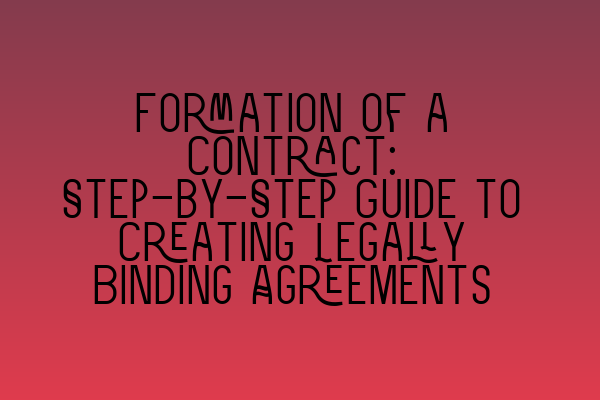Formation of a Contract: Step-by-Step Guide to Creating Legally Binding Agreements
As a solicitor, it is crucial to have a comprehensive understanding of contract law. Knowing how to properly form a legally binding agreement is an essential skill in any legal practitioner’s toolkit. In this article, we will provide a step-by-step guide to help you navigate the intricacies of contract formation.
Step 1: Offer and Acceptance
The first step in forming a contract is the expression of an offer. An offer is a clear indication of willingness to be bound by certain terms. It must be communicated to the party to whom it is being made. Once the offer is presented, the offeree can accept it, indicating their agreement to the terms. Acceptance should be unambiguous and communicated to the offeror.
It is important to note that an invitation to treat, such as an advertisement or a display of goods, is not an offer but an invitation for others to make an offer. The distinction between an offer and an invitation to treat is crucial in determining whether a contract has been formed.
Step 2: Consideration
Consideration is a vital element in contract law. It refers to something of value that each party offers in exchange for the other party’s promise. Consideration can be in the form of money, goods, services, or a promise to do something. Without consideration, a contract cannot be enforceable.
For example, in a sales contract, the buyer’s consideration is the payment for the goods, while the seller’s consideration is the transfer of ownership of the goods. Both parties must provide consideration for the contract to be valid.
Step 3: Intention to Create Legal Relations
For a contract to be enforceable, the parties must intend to create legal relations. Contracts made between family members or friends, known as social agreements, are generally presumed not to have an intention to create legal relations. On the other hand, commercial contracts, employment contracts, and business agreements are presumed to have an intention to create legal relations.
It is important to determine the intention of the parties at the time of contract formation. You should assess the context and the language used to ascertain whether the parties intended for their agreement to be legally binding.
Step 4: Capacity
Capacity refers to the legal ability of all parties involved to enter into a contract. Certain individuals, such as minors, individuals lacking mental capacity, or individuals under the influence of drugs or alcohol, may have limited capacity or no capacity at all to form a contract.
It is important to ensure that all parties are legally capable of entering into the contract. If any party lacks capacity, the contract may be voidable, meaning it can be canceled by the party lacking capacity.
Step 5: Consent
Consent is another essential element in contract formation. All parties must provide consent freely and voluntarily without any undue influence, duress, or misrepresentation. If consent is obtained through fraudulent or deceptive means, the contract may be voidable.
It is crucial to ensure that all parties fully understand the terms and implications of the contract. If there is a lack of genuine consent, the contract may not be considered legally binding.
Step 6: Legal Formalities
Most contracts do not require any specific form or particular language to be legally binding. However, certain types of contracts, such as contracts for the sale of land or contracts that must be in writing to satisfy the Statute of Frauds, may require specific formalities.
It is important to be aware of any legal formalities that may be applicable to the specific type of contract you are dealing with. Failure to satisfy these formalities may render the contract unenforceable.
Conclusion
Formation of a contract requires careful consideration of the above steps. It is crucial to ensure that all elements of contract formation are present to create a legally binding agreement. As a solicitor, understanding these steps and their nuances is essential in providing sound legal advice to your clients.
For more information on navigating legal challenges and pitfalls in your practice, please check out this related article. If you’re interested in the differences between barristers and solicitors, we recommend reading our comprehensive comparison. Understanding the SRA Competence Statement is also crucial for solicitors, so be sure to read our guide for solicitors. If you’re looking to specialize within the field of law, our article on exploring different solicitor specializations will be of interest to you. Lastly, if you’re considering pursuing a legal education, we have recommendations for the top law schools in the UK.
